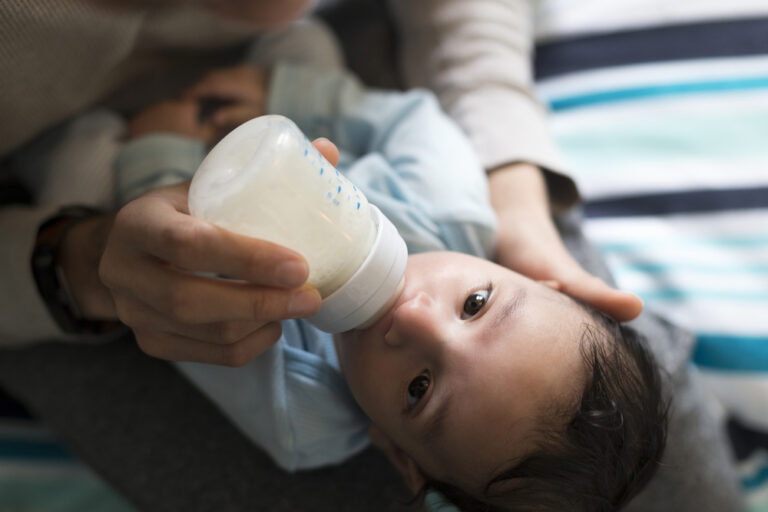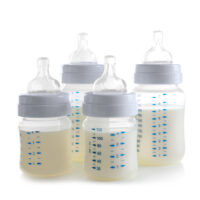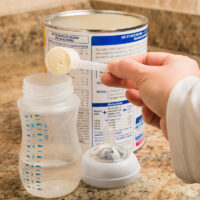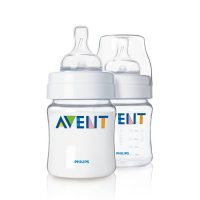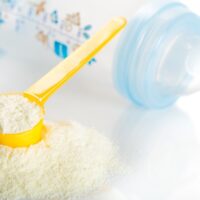When it comes to the temperature of baby’s milk, the only rule is that it should not be scalding hot. It is perfectly safe for babies to drink cold breastmilk or formula straight from the refrigerator. Warming milk is not a necessity but rather a matter of preference. Below we’ll share how to warm a baby’s bottle safely.
Four Safe Ways to Warm a Baby Bottle
There are four ways to safely warm up baby bottles. We will explain each method in detail, along with the tools you will need, if applicable.
1. Set Bottles in Warm Water
This is the easiest and most economical method, but it takes the longest. That’s something to consider if you have a screaming, hungry baby on your hands.
All you need is a pot of warm water, either warmed on the stove, in the microwave, or sourced from the warm water tap. The water should not be hot or boiling. It should also be at least the same height as the milk in your baby’s bottle. Then, place your baby’s bottle in the pot to warm milk to his or her desired temperature. Swirl the bottle during the warming process to make sure the temperature of the milk is even. If the water cools down, replace it with more warm water.
Again, this can take several minutes, depending on how large your baby’s bottles are. (A two-ounce bottle of milk won’t take nearly as long as an 8-ounce bottle.) But this is a reliable method if your baby is on a schedule and you can set aside time to warm the bottle prior to feeding time.
2. Use an Electric Bottle Warmer
Contrary to the first method, this warming process is the fastest, but the most expensive. Purchasing a bottle warmer is a one-time investment (so long as you properly care for the device), and it warms bottles to the right temperature in minutes without needing to swirl the bottle or monitor the heat source.
There are several bottle warmers on the market. Here are a few of our favorites:
Dr. Brown’s Deluxe Baby Bottle Warmer
You’ll get the right temperature for your baby’s bottles every time with the Dr. Brown’s Deluxe Baby Bottle Warmer.
You can use this device as long as your little one is drinking from a bottle. It fits all of Dr. Brown’s bottles and most other bottle brands due to the adjustable basket. The bottom section of the basket can be turned upside down, so shorter bottles sit higher in the heating chamber.
The bottle warmer comes with an instruction guide for how long each bottle should be warmed, as well as an LCD control panel that has a one-button start function. There are audio and visual alerts to let you know when the warming cycle is finished. The device remembers your last heating time, so you don’t have to reset the clock with every use. The bottle warmer also automatically shuts off after ten minutes.
For reference, it took about 5 minutes to heat up my daughter’s 8-ounce milk bottles with Dr. Brown’s Deluxe Baby Bottle Warmer.
The water reservoir is easy to fill. You can heat several bottles before having to refill the reservoir. The Dr. Brown’s Deluxe Baby Bottle Warmer is compact and does not take up precious countertop space in your kitchen.
Baby Brezza Safe and Smart Electric Baby Bottle Warmer
The Baby Brezza Safe and Smart Electric Baby Bottle Warmer safely heats baby’s milk and baby food jars, so you can get a lot of mileage out of this one device.
There are two settings to properly heat baby bottles and food:
- Steady warm for breastmilk: This setting uses a warm water bath to heat or defrost breastmilk to best preserve its nutrients.
- Quick warm for formula and baby food: This setting uses safe, steam heat to rapidly warm formula and baby food.
For added convenience, the Baby Brezza Electric Baby Bottle Warmer can be started with the corresponding app. It will even alert you through the app once the bottle is ready!
There is an auto-shutoff function to prevent overheating if you accidentally forget about the bottle.
Munchkin 98° Digital Bottle Warmer
The Munchkin 98° Digital Bottle Warmer is a convenient way to heat up baby’s milk when you’re on the go.
This small device heats breastmilk or formula to 98.6 degrees Fahrenheit, or body temperature, with every use. It holds bottles at this temperature for up to 30 minutes.
Here’s how it works. Unlike traditional bottle warmers where you place the bottle in the heating chamber, simply screw a milk bottle directly into the base, flip the unit, then press and hold the start button for two seconds. If using baby formula, make sure the formula is mixed beforehand.
It includes 4 adapters to fit most major bottle brands, including Dr. Brown’s, Avent, Medela, Tommee Tippee, and more. Using the proper adapters will ensure a secure, leak-proof fit. This is compact enough to throw in the diaper bag if you need to heat baby’s bottles when you’re out of the house and not near a stove or outlet.
3. Prepare Formula Bottles Using Warm Water
If your little one is formula-fed, an easy way to prepare bottles that are not ice-cold is to use lukewarm water from the tap. There is no need to use cold water to prepare the formula and taking the extra step of heating it up.
But be sure to check with your pediatrician and local officials that drinking the water from your tap is safe. If you are concerned about the purity of your tap water, you could always boil the water first, then let it cool down sufficiently. But this will take some time.
4. Place Bags of Breastmilk Under Warm Water
If you are pumping breastmilk, then chances are you are already using plastic storage bags, such as the Kiinde Milk Storage Bags, to refrigerate or freeze milk.
Because these storage bags are plastic, they are very easy to thaw or warm by placing the bags under warm tap water. The plastic is thin and milk is usually spread in a thin layer then frozen (for optimal storage), so it takes no time at all to safely warm up the breastmilk.
The downside to this method is that it does waste quite a bit of water.
What Not to Do When Warming Baby Bottles
Now that we have discussed the four main ways to safely warm up baby bottles, it is important to mention what you should not do when heating milk.
First, never use a microwave to heat baby’s bottles, even if it is just for a few seconds. According to the AAP and the FDA, microwaves do not heat liquid evenly. It can result in “hot spots” and burn your baby’s mouth and throat when drinking.
You should also avoid using boiling water to warm baby bottles for the same reason: it can cause uneven heating. It is best to use warm water instead.
FAQs about Warming Baby Bottles
How do you check to see if baby’s milk is at the right temperature?
You may have seen and heard the recommendation of the “wrist test,” which is to squirt a bit of baby’s milk on the inside of your wrist to see if it is too hot or not.
But according to the FDA, you should test the warmed-up breastmilk or formula on the top of your hand, not the wrist, which is one of the areas least sensitive to heat. If the milk is appropriate for feeding your baby, it should feel lukewarm.
Can you reheat baby bottles after they have been warmed up?
This is not recommended. Once breastmilk or formula has been reheated and the baby has already started drinking, the bottles only last for a few hours before they need to be tossed.
For breastmilk, thawed or warmed up breastmilk can be used within 2 hours after the baby is finished feeding. After two hours, leftover breastmilk should be discarded, according to the CDC.
Leftover formula needs to be tossed after an hour. If a bottle of formula has already been warmed up and prepared, and your little one has already started drinking, there is a chance bacteria may have formed since the last feeding. That could make your baby sick.
Final Word
Remember, the goal is to warm breastmilk or formula, not heat it up. Even though you may enjoy coffee that is scalding hot, baby can only tolerate milk bottles that feel lukewarm to us.
While it is normal for newborns and infants to prefer warmed-up bottles, it is a good idea to transition older babies away from warmed milk. That’s because many begin drinking cow’s milk once they turn 12 months old. Unless you want to continue warming up whole milk, try to get your little ones used to milk straight out of the refrigerator.
